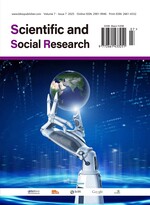Research on Spatial Optimization of Carbon Sources and Carbon Sinks in the Urban Agglomeration around Poyang Lake under the Guidance of Carbon Balance
Abstract
In the context of the advancement of the “dual carbon” goals, research on the carbon source—carbon sink balance of the urban agglomeration around Poyang Lake has very important practical significance. However, due to socio-economic differences in industrial layout and uneven population distribution, there are significant spatial differences in carbon sources and sinks. Based on this, the author will conduct an in-depth analysis of the general situation of the urban agglomeration around Poyang Lake in this paper, and propose corresponding carbon source and carbon sink spatial optimization strategies for the urban agglomeration in combination with the influencing factors of the spatial distribution of carbon source and carbon sink in the urban agglomeration around Poyang Lake, hoping to provide some reference and assistance to readers.
References
Fang XN, 2024, Research on the Spatial Distribution and Clustering Characteristics of Carbon emissions in the Yangtze River Delta Urban Agglomeration. Huazhong Architecture, 2024(11): 12–17.
Cheng XJ, Wang LL, Quan CG, 2024, Structural Characteristics and Influencing Factors of the Spatial Correlation Network of Carbon Emissions in the Changsha-Zhuzhou-Xiangtan Urban Agglomeration. Journal of Changsha University, 38(5): 61–69.
Zhou B, Xu YX, Feng T, 2024, Spatial Differentiation and Optimization Strategies for Carbon Balance in the Chengdu-Chongqing Urban Agglomeration. Resources and Environment in the Yangtze Basin, 33(8): 1650–1662.
Quan TS, Zhang H, Xu YY, 2024, The Spatial Correlation Network of Carbon Emission Efficiency in the Yangtze River Delta Urban Agglomeration and its Influencing Factors. Journal of Nanjing Forestry University (Natural Science Edition), 48(6): 217–228.
Sun XC, Zhu J, Zhou S, 2024, Study on the Spatial Correlation Network Structure and Influencing Factors of Carbon Footprint Pressure in the Beijing-Tianjin-Hebei Urban Agglomeration. Statistics and Management, 33(3): 4–17.
Liang SY, Kong YY, Zou ML, et al., 2023, Carbon Based on Spatial Heterogeneity of the Pearl River Delta Urban Agglomeration Drivers Study. Journal of Environmental Science, Lancet, 2023(11): 237–244.
Wang ZQ, 2023, Research on the Spatial Effects of Carbon budget and the Construction of Carbon Balance Zones in the Beibu Gulf Urban Agglomeration, thesis, Guangxi University.
Zhao LQ, 2023, Computational Research on the Spatial Allocation of Carbon Quotas in Urban Agglomerations in the Middle and Lower Reaches of the Yellow River, thesis, North China University of Water Conservancy and Hydropower,
Jiang WZ, 2023, Identification and Analysis of the “Three Living Spaces” of Jiaodong Urban Agglomeration based on Multi-Source Spatial Data, thesis, China Mining University.
Zheng H, Ye AZ, Spatial Correlation Carbon Network Structure and its Influencing Factors. China Environmental Science, 2022(5): 2413–2422.
Shi Y, 2021, Research on the Spatial Pattern of Carbon Sources and Sinks in Urban Agglomerations. Liaoning Science and Technology Press, Shenyang, 233.
Wang XP, Feng Q, Song JZ, 2020, Carbon Chengdu-Chongqing Urban Agglomeration Spatial Correlation Structure Evolution and its Influence Factors. China Environmental Science, 40(9): 4123–4134.
Xu HT, 2018, Analysis of Spatial Differences in Carbon Emissions in Urban Agglomerations and Policy Simulation for Decision Support, thesis, Qingdao University of Science and Technology.
Chen CC, Cai BF, Sun F, et al., 2017, Comparison of Spatial Agglomeration Effects of Carbon Emissions in the Beijing-Tianjin-Hebei Region and the Yangtze River Delta Urban Agglomeration. China Environmental Science, 37(11): 4371–4379.
Shi Y, 2017, Research on Optimizing the Spatial Pattern of Carbon Sources and Sinks in the Liaozhong Urban Agglomeration, thesis, Tianjin University.

